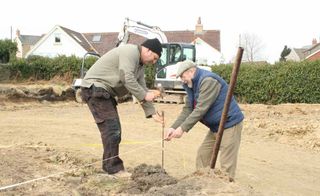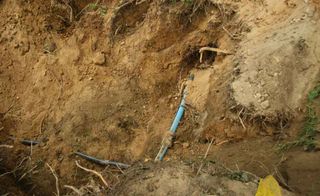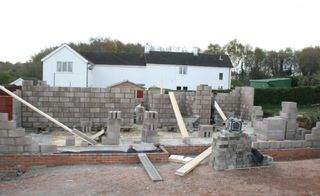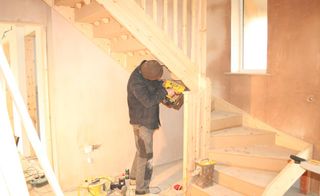Building a House Step by Step: A Guide From Start to Finish
Understanding the process of building a house step by step will help you keep track of the schedule as your project progresses. Here we explain what to expect at each stage of the build

Knowing the process of building a house step by step is important when taking on a self build, whether you are project managing or passing over the baton to someone else on the team.
Understanding what to expect at each stage of the build will give you the confidence to engage with trades at certain points along the way and generally feel comfortable with the build process.
This is especially crucial when acting as your own project manager or undertaking any of the work yourself, so that you can make sure that the materials arrive and the trades are contracted at the right time for a smooth build.
An Introduction to Building a House Step by Step

Need more advice or inspiration for your project? Get two free tickets to the Homebuilding & Renovating Show
The construction process of building a house is broken down into two distinct elements — pre and post weathertight stage (this is also called ‘getting a house to shell’).
A house is deemed to be ‘weathertight’ (sometimes also called ‘watertight’) when the walls are up, the roof is on, the windows and doors are in and it’s all fully lockable — and, from the outside, resembles a finished house.
Getting a house weathertight is easily the most exhilarating part of the process for beginners — it’s when all the heavy work is done, and real progress can be seen almost every day. Depending on its size and complexity, most builders would expect to get a house weathertight in three to six months.
Once a house is weathertight, work can commence inside. Owing to the complexities of houses, there is a convoluted schedule that needs to be followed – the plasterers can’t work at the same time as the initial electrics are being done, for instance – which tends to mean that it’s this element of the process that can drag on a bit.
So, in total, expect a house to go from ‘breaking ground’ (the traditional start of a project where the trenches are dug for the foundations) to moving in over a period of six and 12 months. At extreme ends, some timber frame package companies claim to be able to get a house ready and liveable within six months. Many DIY self-builders take upwards of three years.
The schedule varies hugely depending on how the project is approached but below is an overarching step-by-step guide that will give you a real understanding of the stages from breaking ground to final sign-off.
1. Site Preparation for Building a House
Assuming you have bought your plot and all of your planning and preparatory work is in place, the first step when building a house is to prepare the site. This not only includes clearing the site of debris and vegetation, but also ensuring your have the necessary facilities and services set up for your tradespeople.
Here's an idea of the tasks at this pre-build stage:
- Groundworkers create site access
- Clear site and strip vegetable soil; stacking material to be retained out of the way
- Set up site hut and equip with drawings and safety equipment
- Set up toilet
- Secure lock-up/lorry container (hired in or purchased) to be positioned
- Water board to bring supply to stopcock on boundary
- Plumber to connect water standpipe
- Surveyor marks out building on cleared site and transfers the lines to profiles well clear of any construction work
- Bring in bricks and blocks and stack clear of future construction
- Set up mixer station close to cement store and sand heap

2. Laying the Foundations for Building a House
Next up, you need to start on your foundations. The cost of constructing foundations is one of the biggest variables in a self-build project, so anyone who wants to keep control of their budget and schedule needs to work out the most appropriate foundation system to use as early as possible.
Once the most cost-effective solution has been identified - usually via a geotechnical study, which involves digging or boring trial holes around the site of a proposed new building - and your site is ready your foundations can be laid.
(MORE: Foundation systems and soil types)
Here are the tasks for this step:
- Groundworkers excavate foundations
- Wait for approval of building control and warranty inspectors
- Position any reinforcement bars, mesh or cages in the trenches
- Position any compressible material or slip membranes required within the trenches
- Lay ducts for services to enter through the foundations
- Arrange foot scaffold if necessary and shutter for any steps in the foundations
- Pour concrete footings and tamp to level
- Obtain approval from building/warranty inspectors to proceed
- Bricklayers build up foundation blockwork to damp-proof course
- Install cranked air vents
- Install drainage exit lintels
- Fill cavities with lean-mix concrete to level with external ground level
- Bed and lay damp-proof courses, linking these with any radon membranes or barriers

3. Building a House's Superstructure
Getting underway with the superstructure is an exciting part of building a house. Make sure you are aware of the stages when you will need sign off from a building inspector.
- Groundworkers to dig service trenches and lay pipes and ducts to proposed stopcock/meter positions
- Load out concrete floor beams to each bay and position
- Install drainage and vent pipes proud of the oversite
- Infill floor beams with blocks
- Lay coursing blocks and position ventilator grilles
- Brush grout
- Arrange for building control/warranty inspection
- Commence building superstructure
- Install templates for future windows and doors, etc.
- First lift of scaffolding required

(MORE: How long will it take to build your own home? Check out this typical self build schedule)
Continue Building the Superstructure

- Bricklayers continue superstructure brickwork and blockwork, including work on any chimneys
- Install and bed lintels, including fireplace lintels
- Install flue liners as work proceeds
- Build in meter boxes for gas and electricity
- Electrician to install temporary consumer unit within electricity meter box
- Service suppliers to carry out their work to the boundary
- Plumber to reroute water supply to stopcock position
- Electricity providers to install meter and connect
- Second scaffolding lift required
- Arrange crane to lift first floor beams onto each bay and position (if required)
- Position the plasterboard batten clips
- Lay infill blocks
- Brush grout
(MORE: Build Cost Calculator)
Building up to the Wallplate
- Continue building superstructure to wallplate
- Third and then fourth lift of scaffolding required
- Wallplate to be scarfed, bedded and tied down with proprietary wallplate straps
- Warranty inspection sometimes required
- Carpenters to build end trusses as templates
- Continue building up gable ends and chimney
- Additional lifts of scaffolding required at the gable ends
- Plumber to fit lead flashings, trays and skirts to chimney
- Plumber to install vent pipes and flashing skirts as they come through the roof
- Bricklayers to top out and fit chimney pot
- Bricklayers to point chimney flashings
4. Building a House's Roof
When building a house, you’ll see it really coming together when it’s time to add the roof.

- Carpenters to sling roof trusses, and trusses to be fixed down to wallplate
- All binders and bracing to be fixed at node points
- Layboards to be fixed to valleys
- Dormers to be constructed at this point
- Fascia and soffit to be fixed together with any necessary ventilation grilles or strips
- Warranty inspection sometimes required
- Any roof tanks must be installed at this point
Adding the Roof Covering When Building a House
- Roofers begin to cut and lay undercloaking to the verges
- Roofers to felt and batten
- Tiles/slates to be laid
- Ridge/hip tiles to be laid and bedded
- Valley tiles to be laid, or fibreglass or lead valleys to be laid
- Plumber to dress down flashings and skirtings
- Decorators to paint/stain fascias, soffits and barges
5. Exterior and Interior Fittings Tasks When Building a House
Once the superstructure has been built the next step involves certain internal and external tasks, such as window joinery and any stud wall partitions.
- Plumbers to fix guttering
- Window suppliers to fit external joinery
- Plasterers to carry out any external rendering
- Scaffolding to come down
- Plumbers to fit downpipes and connect to drainage
- upstands/gullies
- External decoration
- Carpenters to commence first fix by fitting door linings, building any studwork partitioning and fixing window boards
- Carpenters to fix plasterboard noggins and box in vent pipes
- Plumber and carpenter to liaise with building of any necessary stands in roof
- Carpenter to fix loft trap
6. First Fix Stage of Building a House
This step sees the electrical and plumbing runs put in place.
- Plumbers to lay flooring membrane and insulation, taping all joints and sealing up to the damp-proof course
- Underfloor heating (UFH) loops to be laid and fixed
- All first fix plumbing for hot and cold and waste within floor zones to be laid
- Internal gas pipework installed
- UFH pipework to be brought to manifolds and outlet positions
- Supply and fix company to pump in and lay level floor screed and leave for three days
- Protective hardboard/ cardboard to be laid on screed
- Electrician to fix carcass wiring for lighting and power circuits together with all backplates
- Consumer unit/units to be positioned
- Wiring taken to external lighting points
- TV aerial/satellite cables to be installed to required positions
- Internal telephone wiring to be installed to required positions
- Home entertainment/smart systems/alarms to be carcassed
7. Drainage and External Works
This step is all about drainage runs, driveways and pathways...
- Groundworkers to begin digging the trenches for drainage runs
- Trenches backfilled to 150mm with pea shingle
- Drains laid to required falls
- Brick/concrete section manholes constructed, or purpose-made manholes, rodding eyes and gullies set in runs
- Building inspector to approve laid drains
- Drains haunched over with pea shingle
- Drainage trenches backfilled
- Work to connect to main sewer in road to be carried out by approved contractors
- Carpenter to finish boxings and noggings ready for plasterer
- Groundworkers to commence driveways and pathways
- Bricklayer to build any fireplaces and hearths
- Gas meter to be installed and connected
- Plumbers and electricians to liaise on all cross bonding and earthing
8. Preparing Ceilings/Dry Lining
Now you’re attention really turns to the interiors.

- Main staircase to be fitted by the carpenter and protectively covered
- Dryliners/plasterers tack ceilings
- All external and blockwork walls lined with plasterboard on dots and dabs
- All studwork walls and pipe boxings tacked with plasterboard
- All joints and angles filled and scrim taped
- All abutments of differential materials jointed with mesh
- All joinery to be sealed internally and externally with mastic
- Dryliners/plasterers to skim coat all walls and ceilings
- Decorator to paint/treat backs of all skirting and architraves
- All roofing insulation to be installed
9. Second Fix Carpentry
It's time in the schedule for the details to be added, such as architraves, skirting and flooring.

- Carpenters hang internal doors
- Skirting and architrave to be fitted by carpenters
- Bottom tread of staircase to be fitted, balustrading and handrails to be fitted, as well as linen cupboard shelving
- Fit of loft door and ladder
- Timber floors to be laid by carpenters or specialists and protected
- Ceramic floor tiles to be laid by specialist tilers and protected
- Carpenters/specialist suppliers to fit/build built-in bedroom and bathroom furniture
- Kitchen units to be fitted
10. Second Fix Stage Electrics and Plumbing
Second fix stage sees everything wired up and connected.
- All wiring connected to consumer unit
- Boiler to be positioned, plumbed and then wired in
- Sink units to be plumbed in, earthed and cross bonded
- All sanitaryware to be fitted and plumbed in
- Radiators and towel rails to be fitted and plumbed in
- Underfloor heating loops to be connected to manifolds
- Electrician to check cross bonding and earthing to all sanitaryware, sinks, radiators, etc
- Boiler to be wired in; control systems and room thermostats to be wired in
- Plumber and electrician to attend firing up and commissioning of boiler
- All pipework and connections to be flushed through and pressure tested
- Central heating to be left on ‘test’
11. Decorating
Those using a package company or main contractor to build their house may choose to pick up the reins at this point and undertake the decorating tasks themselves.
Taking on these smaller tasks at the end of a building project is a good idea if you have gone over budget. (But as always, do only take on jobs that are within your capabilities. Otherwise you could have to pay a premium to get a professional to fix your mistake).
(MORE: How to Paint a Room Like a Professional)

- Worktops, made from the previously taken templates, to be fitted
- House to be thoroughly cleaned with all debris and dust removed to outside
- Decorators to snag any holes, blemishes or rough patches on walls, making good
- Internal timber to be sanded smooth or rubbed down with wire wool
- Decorators to paint all walls and ceilings, mist plus two coats of emulsion
- Internal timber to be knotted, painted, primed, undercoated and top coat glazed, or internal timber to be two-coat stained
- Specialist tilers to fix ceramic wall tiles to kitchen and utility
- Baths to be filled, in order to settle, before tilers fix any wall/splashback tiles
- Water meter to be installed
12. Landscaping

If the budget is tight, some self builders choose to have a bit of a break between completing the house and turning their attention to the landscaping.
But there may be some benefits to landscaping at the same time as building a house so careful consideration about what you want and who will do the work is key.
- Groundworkers or landscape gardeners to level the ground and prepare
- Topsoil from storage to be placed where required, with extra shipped if necessary
- Site hut to be removed or re-sited if intended for use as a garden shed
- Secure site storage to be sold off or returned to hirers
- Groundworkers to complete driveway surface
- Patio slabs to be laid
- Bricklayers to build any required dwarf/ decorative walling
- Lawned areas to be levelled ready for seeding or turfed
- Approved contractors to complete any bellmouth and kerbing to road
13. Final Stage of Building a House
And the time has come! Just a few more tasks to complete before move in day...
- Whole house to be thoroughly cleaned out
- All windows polished and all labels removed from glass and appliances
- All polystyrene packing to be removed from cookers
- All stabilising bolts to be removed from washing machines/driers
- Site toilet and any remaining plant on hire to be off-hired
- Readings to be taken on all meters
- Central heating switched to ‘run’
- Telephone company to connect
- Contractors to install TV aerials and/or satellite dishes
- All trades return to work through items on the snagging list
- Carpets to be laid
- Local authority to be advised of completion to arrange for council tax valuation
- Energy Performance Certificate to be prepared and sent to building control
- Building control final inspection and issuing of Completion Certificate
- Warranty inspector’s final inspection and issuing of warranty
- Arrange protective covering for floor surfaces prior to delivery of furniture
- Switch self build site insurance policy to homeowners’ policy
Get the Homebuilding & Renovating Newsletter
Bring your dream home to life with expert advice, how to guides and design inspiration. Sign up for our newsletter and get two free tickets to a Homebuilding & Renovating Show near you.
David is one of the UK's leading self build and plotfinding experts, and a serial self builder who has been building homes for 50 years. The author of Building Your Own Home, David spent decades as a speaker and expert at self build exhibitions such as the Homebuilding & Renovating Show. He has recently finished his fourteenth self build project.
